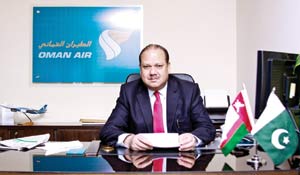The Money Matters got a chance to speak to Ken Marshall, Country Manager, Oman Air,
The Money Matters got a chance to speak to Ken Marshall, Country Manager, Oman Air, who spoke at length about the different plans the airline has for future expansion and what challenges it faces in the local aviation industry. Oman Air was founded in 1993. At present Oman Air flies to 49 destinations in over 27 Countries across the sub continent, Far East, Middle East, Africa and Europe. It is a growing airline and will offer even more destinations following the arrival of the additional new jets that are currently on order.
Q. Are there any plans to hire workforce from Pakistan and invest in the Pakistani aviation industry?
A. Searching for the very best human resource is an on-going process and never stops. That search has taken Oman Air to Pakistan, where we have hired staff both directly and indirectly.
Since Oman Air is government owned, every investment is carefully scrutinised before moving forward. Any potential investment in the Pakistani aviation industry will depend on a range of factors, but any step which contributes to the growth and commercial success of Oman Air will be seriously considered.
Q. What are the challenges in the aviation industry of Pakistan?
A. Every industry in its respective field or sector faces its own challenges. Every region has its own set of challenges and strategies to deal with them. If we talk about Pakistan, the biggest challenge prevalent is the uncertainty of visas on Pakistani passports. However, it is a situation over which the industry has little or no control, as other governments regulate visa policies.
Q. How do you see Pakistan’s aviation industry?
A. Pakistan’s aviation industry is ever-growing. Partly as a result of Pakistan’s increasing Middle Class, there have been many more first time travellers and the trend is set to continue as the economy expands. Sialkot, Faisalabad, Quetta and Multan have opened their doors for international air traffic, signifying the ever-growing dynamics of the industry. This decision has also enhanced the array of options passengers have at their disposal.
Q. What measures are to be taken to boost the aviation sector?
A. The industry is already in a boom phase. With the economy of the country following a trend of improvement, we have seen a surge in international air travel over the years. Last year, we witnessed a dip in some sectors owing to visa restrictions. However, the overall trend has been positive and promising. The government is playing a critical role to boost the aviation industry.
Q. What are the expansion plans of Oman Air and how much is it willing to invest?
A. Expansion is always on the cards at Oman Air. Over the last year, we have increased our fleet size from 30 to 40 aircraft, and we aim to operate a fleet of 70 aircraft by 2020. In addition to new Airbus A330s and Boeing 737s, Oman Air has already received deliveries of two Boeing 787 Dreamliners, and four more are on order.
Our growth has enabled us to offer more destinations within our network. Over the last 12 months, we have launched new routes to Manila, Jakarta, Singapore, Dhaka and Goa. Many additional routes are under consideration for the future.
Investment depends on various factors and requirements. Oman Air is the National Carrier of the Sultanate of Oman and the government holds a stake of more than 99 percent. Since it is a government owned airline, every expansion move is carefully analysed before moving ahead.
Q. Where do you see Oman Air in the long run?
A. Earlier this year, Paul Gregorowitsch, the CEO of Oman Air, reaffirmed our vision for Oman Air to “be the best”. To achieve this vision, Oman Air has ambitious plans to expand of its fleet, increase the number of destinations offered and, crucially, continuously improve its onboard and on ground services.
A new airport at Muscat is scheduled to open by the end of 2016 and we look forward to continuing to offer the highest levels of Omani hospitality in the new airport lounges. The overall plan with the new airport is to utilise its much greater capacity to make Muscat the principal gateway to the Middle East, and to all the other sectors that Oman Air covers.
I have no doubt that, with the current pace and strategy, it is only a matter of time before Oman Air is officially classified as one of the best airlines of the world.
The writer is a staff member